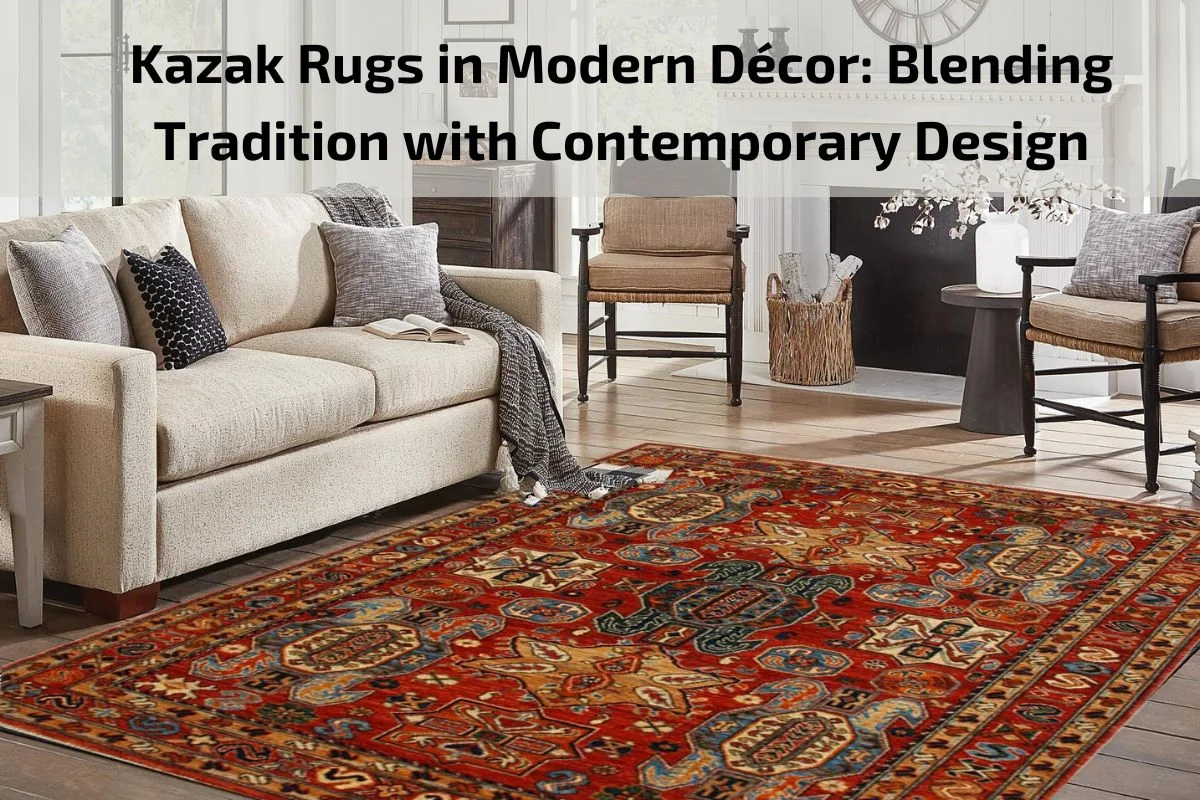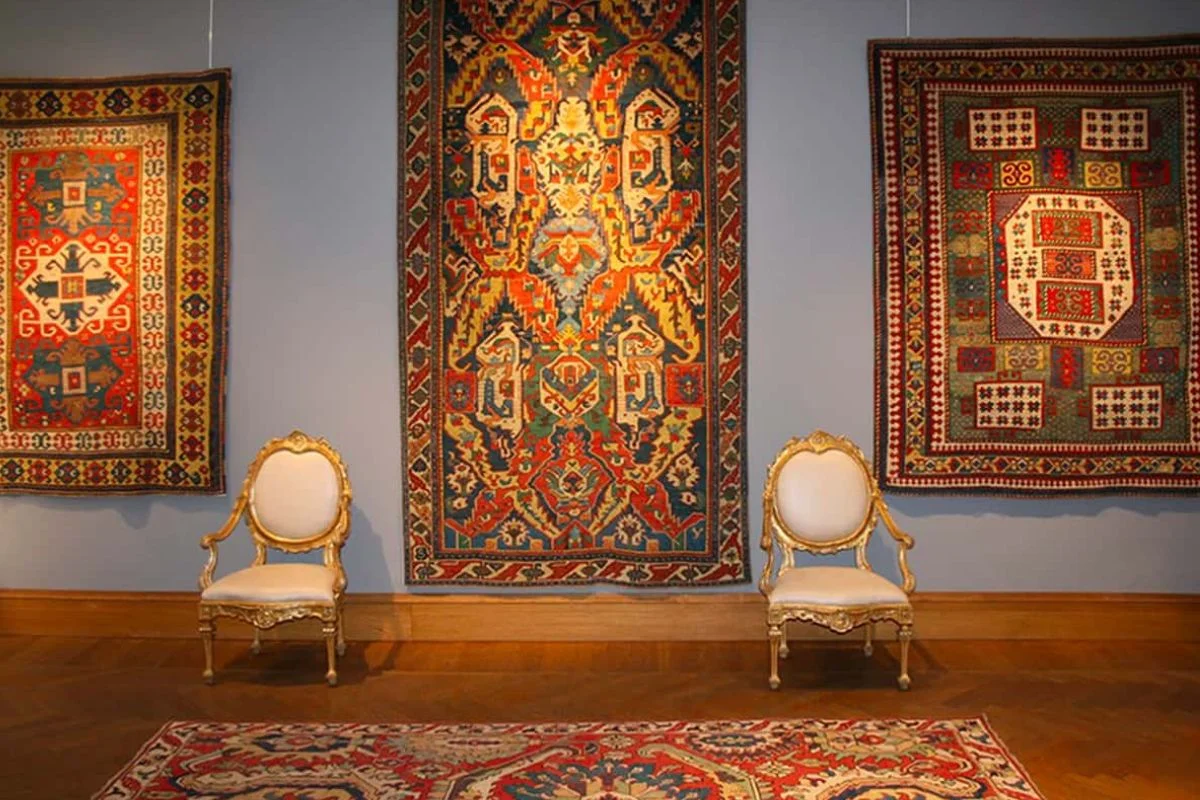Kazak Rugs in Modern Décor: Blending Tradition with Contemporary Design

In today’s fast-paced world, the allure of tradition often finds itself juxtaposed against the sleek lines and minimalist aesthetics of modern design. Yet, amidst this clash of old and new, there exists a harmonious fusion that seamlessly marries the time-honored craftsmanship of the past with the contemporary sensibilities of the present. Enter Kazak rugs – exquisite treasures that effortlessly bridge the gap between tradition and modernity, enriching any space they inhabit with their vibrant colors, intricate motifs, and rich cultural heritage.
The art of Kazak rug weaving traces its roots back centuries to the rugged landscapes of the Caucasus region, where skilled artisans meticulously crafted these masterpieces by hand, infusing each knot and thread with stories of heritage and tradition. Today, these same rugs continue to captivate admirers around the globe, not only for their undeniable beauty but also for their ability to breathe new life into modern interiors.
Brief overview of Kazak rugs
Kazak rugs are a type of hand-woven rug originating from the Caucasus region, particularly Armenia, Azerbaijan, and Georgia. They are renowned for their bold colors, geometric designs, and durable construction. Traditionally made by skilled artisans using wool sourced from local sheep and natural dyes, Kazak rugs boast a rich history dating back centuries. These rugs often feature symbolic motifs such as animals, plants, and geometric shapes, each carrying cultural significance and storytelling elements. Kazak rugs have gained popularity in modern interior design for their versatility in complementing various decor styles, from traditional to contemporary. With their timeless elegance and craftsmanship, Kazak rugs continue to be cherished as both decorative pieces and cultural treasures.
Importance of Kazak rugs in interior design and decor
Kazak rugs play a significant role in interior design and decor for several reasons:
Distinctive Aesthetic Appeal: Kazak rugs are renowned for their vibrant colors, bold geometric patterns, and intricate designs. Their unique aesthetic adds warmth, character, and visual interest to any space, making them a sought-after choice for interior designers and homeowners alike.
Versatility: One of the key advantages of Kazak rugs is their versatility. They can effortlessly complement various decor styles, from traditional to contemporary, rustic to eclectic. Whether used as a focal point in a room or as a subtle accent piece, Kazak rugs have the ability to tie together different elements of a space and enhance its overall ambiance.
Cultural Heritage and Authenticity: Kazak rugs carry a rich cultural heritage and authenticity that adds depth and significance to interior spaces. Each rug tells a story through its motifs and symbols, reflecting the traditions, beliefs, and history of the communities that produce them. Incorporating Kazak rugs into interior design not only adds aesthetic value but also serves as a nod to centuries-old craftsmanship and cultural identity.
Handcrafted Quality: Hand-woven by skilled artisans using traditional techniques passed down through generations, Kazak rugs are synonymous with quality craftsmanship. Their durable construction ensures longevity, making them not only beautiful additions to a home but also practical investments that can withstand the test of time and foot traffic.
Artistic Expression and Personalization: Kazak rugs offer an opportunity for artistic expression and personalization within interior spaces. With a wide range of designs, colors, and sizes available, homeowners can select a Kazak rug that resonates with their individual style preferences and design sensibilities, adding a personal touch to their living environment.
Materials used in Kazak rug
Kazak rugs are crafted using natural materials and traditional techniques, resulting in durable and visually stunning pieces. Here are the primary materials used in the creation of Kazak rugs:
Wool: Wool is the most common material used in Kazak rug making. It is sourced from local sheep breeds in the Caucasus region, known for their high-quality fleece. Wool provides several advantages, including durability, softness, and resilience to wear and tear. Additionally, wool naturally absorbs dyes, allowing for vibrant and long-lasting colors in Kazak rug designs.
Natural Dyes: Traditional Kazak rugs are dyed using natural ingredients sourced from plants, minerals, and insects. These natural dyes produce rich and earthy tones that add depth and authenticity to the rugs. Common natural dye sources include indigo, madder root, walnut husks, pomegranate skins, and cochineal insects. Natural dyes are prized for their environmental sustainability and the unique patina they develop over time.
Cotton: While wool is the primary material for the pile (the visible surface of the rug), cotton is often used for the warp and weft threads, which form the foundation of the rug. Cotton provides strength and stability to the structure of the rug, ensuring its longevity and integrity. Cotton is also used for the fringe at the ends of the rug, adding a finishing touch to the design.
Metallic Threads (optional): In some Kazak rugs, metallic threads such as silver or gold may be incorporated into the design to add shimmer and embellishment. These threads are typically used sparingly as accents, highlighting specific motifs or borders within the rug’s composition.
Kazak Rugs in Modern Interior Design
Kazak rugs have experienced a resurgence in popularity within modern interior design circles, thanks to their timeless appeal, versatility, and ability to add character to contemporary spaces. Here’s how Kazak rugs are making their mark in modern interior design:
Statement Pieces: Kazak rugs serve as striking statement pieces in modern interiors. Their bold colors, geometric patterns, and intricate designs instantly draw attention and become focal points within a room. Whether displayed against neutral flooring or layered over carpets, Kazak rugs inject personality and visual interest into minimalist, industrial, or eclectic spaces.
Eclectic Fusion: In the trend of eclectic interior design, Kazak rugs play a crucial role in bridging different styles and elements together. Their traditional motifs and vibrant hues provide a counterbalance to sleek, modern furniture or industrial accents, creating a harmonious fusion of old and new. Mixing and matching Kazak rugs with contemporary decor pieces add layers of texture and history to the space.
Color and Texture: Kazak rugs offer an opportunity to experiment with color and texture in modern interiors. Their rich, saturated hues can infuse warmth and depth into monochromatic or neutral color schemes. Additionally, the plush wool pile of Kazak rugs provides a luxurious texture underfoot, adding coziness and comfort to modern living spaces.
Global Influence: With a growing interest in global-inspired decor, Kazak rugs bring a touch of cultural authenticity to modern interiors. Their origins in the Caucasus region and the intricate craftsmanship behind each piece add depth and narrative to interior spaces. Incorporating Kazak rugs allows homeowners to connect with different cultures and traditions while expressing their individuality through design.
Versatile Styling Options: Kazak rugs offer versatile styling options for modern interiors. They can be used in various rooms, from living areas and bedrooms to home offices and dining spaces. Whether displayed as a central rug in a seating area or hung as a tapestry on a wall, Kazak rugs adapt to different design needs and preferences, providing endless possibilities for creativity and personalization.
Buying Guide: Tips for Choosing and Caring for Kazak Rugs
Quality Assessment:
- Inspect the rug for even weaving, tight knots, and consistent pile height.
- Look for vibrant, evenly applied colors and well-defined patterns.
- Check the rug’s density and weight, which indicate durability and craftsmanship.
Authenticity:
- Purchase from reputable sources or dealers specializing in handmade rugs.
- Look for a certificate of authenticity or documentation confirming the rug’s origin and materials used.
Size and Placement:
- Measure the area where the rug will be placed to ensure the proper fit.
- Consider the rug’s purpose (e.g., focal point, accent piece, or room divider) and choose a size accordingly.
Design and Color:
- Select a design and color palette that complements your existing decor and personal style.
- Keep in mind the room’s color scheme and furniture when choosing the rug’s pattern and hues.
Material and Construction:
- Opt for rugs made from high-quality wool and natural dyes for durability and longevity.
- Check the rug’s construction, including the density of knots and thickness of the pile, to gauge its quality.
Care and Maintenance:
- Vacuum the rug regularly to remove dust and debris, using a brush attachment or low suction setting.
- Rotate the rug periodically to ensure even wear and sun exposure.
- Spot clean spills immediately with a clean, damp cloth and mild detergent, blotting the area gently.
- Avoid placing heavy furniture directly on the rug to prevent crushing or indentations.
- Consider professional cleaning by a rug specialist every few years to deep clean and maintain the rug’s condition.
Protection and Preservation:
- Use a rug pad underneath the rug to provide cushioning, prevent slipping, and protect the floor underneath.
- Avoid exposing the rug to direct sunlight or high humidity, as it can cause fading, discoloration, or mold growth.
- Store the rug properly when not in use, rolling it with the pile facing inward to protect the fibers.
Conclusion
In conclusion, Kazak rugs represent not only exquisite craftsmanship but also a rich tapestry of cultural heritage and timeless elegance. Their enduring appeal in modern interior design stems from their ability to infuse spaces with warmth, character, and visual intrigue while serving as a testament to centuries-old traditions.




0 comments